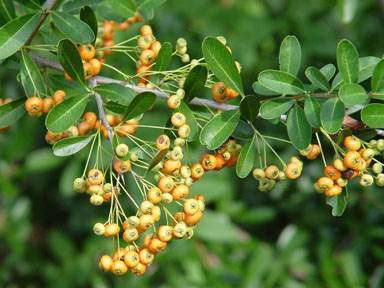
Pauline Singleton,
Houston-Galveston Invaders
Family: Rosaceae (Rose Family)
Synonym(s): Cotoneaster pyracantha
Duration: Perennial
Habit: Shrub
Listed by:
Invasive Plant Atlas of the US: 1
Federal Noxious Weed: 0
TDA Noxious Weed: 0
TPWD Prohibited Exotic Species: 0
Description: Firethorn is a large, evergreen shrub that is cherished for its spectacular fall and winter display of scarlet fruits and ability to withstand dry and droughty conditions. Shooting long lanky stems in all directions, firethorn typically grows into a tangled mound up to 10 ft (3.1 m) in height and 12 ft (3.7 m) wide. It is armed with sharp thorns that hide among the dark, glossy green leaves. Clusters (corymbs) of small white flowers appear in spring.
History: Arrived to the U.S. as a common ornamental plant which is still used in landscaping. Due to its dense shrubbery, it is used in many states as a property divider.
Biology & Spread: Birds readily eat berries and disperse seeds. Deer are thought to avoid this shrub because of the plant's sharp spines.
Ecological Threat: Out competes native species in forested areas. Can also impact animals within the ecosystem that are not able to forage from the plant.
US Habitat: It can grown in dry to medium moisture, well-drained soil from full-sun to part shade exposure. It does best in fertile soils with sharp drainage, and is tolerant of clay soils as well as drought conditions.
Distribution
US Nativity: Introduced to U.S.
Native Origin: Southern Europe to Caucasus Mountains in western Asia.
US States: AL, CA, DC, LA, MS, NM, OH, OR, PA, TX, UT
Resembles/Alternatives:
Management:
USE PESTICIDES WISELY: ALWAYS READ THE ENTIRE PESTICIDE LABEL CAREFULLY, FOLLOW ALL MIXING AND APPLICATION INSTRUCTIONS AND WEAR ALL RECOMMENDED PERSONAL PROTECTIVE GEAR AND CLOTHING. CONTACT YOUR STATE DEPARTMENT OF AGRICULTURE FOR ANY ADDITIONAL PESTICIDE USE REQUIREMENTS, RESTRICTIONS OR RECOMMENDATIONS. MENTION OF PESTICIDE PRODUCTS ON THIS WEB SITE DOES NOT CONSTITUTE ENDORSEMENT OF ANY MATERIAL.
Listing Source
Texas Department ofAgriculture Noxious Plant List
Texas Parks and Wildlife Department Prohibited Exotic Species
Invaders Program
Federal Noxious Weed
Union of Concerned Scientists
United States Forest Service Southern Research Station
Text References
Floridata. 2005. Pyracantha coccinea. (Accessed 20 August 2010: http://www.floridata.com/ref/p/pyra_coc.cfm)
Data Source
Last Updated: 2023-03-28 by